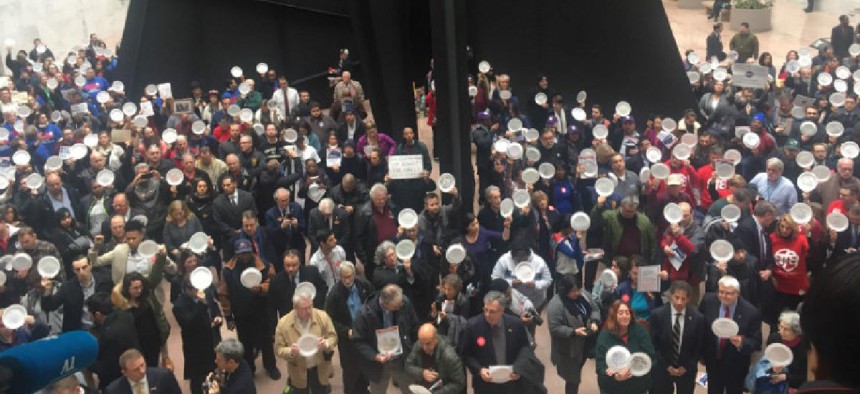Feds, union chief arrested protesting shutdown on Capitol Hill

While lawmakers and the White House traded barbs and remained deadlocked, protesting feds and supporters flooded a Senate office building.

Protesters in the lobby of the Hart Senate Office Building on Jan. 23, 2019. (Photo credit: Chase Gunter/FCW)
Federal employees demonstrating against the month-old government shutdown filled the lobby of the Hart Senate Office Building on Capitol Hill on Jan. 23.
After a largely silent protest lasting about 33 minutes – to represent the number of days of the shutdown -- hundreds of feds and supporters began chanting, "no more food banks" and "we need paychecks," before Capitol Police warned protestors to stop and disperse.
While most protestors ultimately cleared the Senate offices without incident, dozens of protestors took to Senate Majority Leader Mitch McConnell's (R-Ky.) office in a nearby Senate building, where some chanted and sat in the hallway until they were arrested and escorted out of the building. Maybe a dozen protestors, including president of the American Federation of Government Employees J. David Cox, were arrested.
Brad Hufford, a furloughed FEMA employee who traveled from Colorado to attend, said he heard about the protests yesterday and decided it was important to attend.
"Yesterday morning I was on my couch," he said, saying he used travel points to make the last-minute trip.
Hufford, whose office manages $1.5 billion in grants, said he feared the widespread furloughs add risk in the event of an earthquake or other natural disaster. But even without a disaster, Hufford said that there's financial risk of his grants portfolio going unmonitored.
"I'm not making sure those are managed in a fiscally responsible way," he said. "That's the type of work that goes unnoticed."
Michael Knowles, an asylum officer at the U.S. Center for Immigration Services, said while his particular office remains open because it's funded through fees, much of the data his office relies on requires collaboration with employees who have been furloughed.
Those interagency projects and tasks that touch the work "everybody does" have limited the effect of even the areas that have stayed open, or are excepted as essential, such as the law enforcement components of the Department of Homeland Security.
He said some of the IT workers who were sent home earlier in the shutdown have recently been called back and reassigned to work in other, fee-funded areas of the department.
Matthew Sisson, Commanding Officer for the Research and Development Center at the Coast Guard, said he'll have to start dipping into his 401K and Thrift Savings Plan funds next month.
Sisson's office is working on the consolidation of three antiquated tech systems. The shutdown has disrupted that rollout, and workarounds are costly. He said he fears qualified tech employees, even if they don't leave government altogether, could decamp to the Department of Defense as a result of the lapse in pay.
The Office of Personnel Management is trying to mitigate some of the effects of the shutdown on essential and excepted employees working without pay. In a Jan. 23 memo, acting OPM Director Margaret Weichert urged managers to permit telework and flexible schedules where possible, and to permit excepted employees to request and use time off or to obtain excused periods of absence to be considered as furlough status – for which they will be paid after the government is reopened.
Congress looks no closer to a solution on the underlying dispute over the controversial border wall. The U.S. Senate will hold two votes on Thursday on bills to reopen the government, one based on a White House proposal with wall funding and another from the House which would reopen government through Feb. 8 that doesn't include funding for the border wall.





